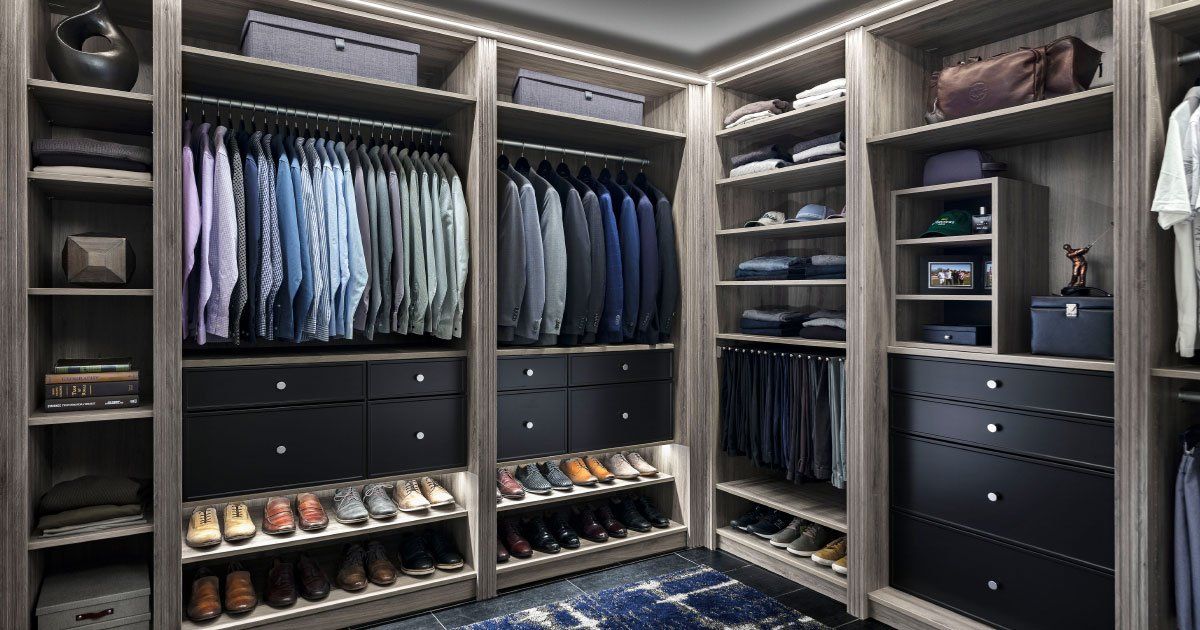
Just hearing the word mold probably makes you cringe, but discovering it in your custom closets is an even worse feeling. Dark, humid and poorly ventilated spaces are ideal environments for mold to thrive.
For mold to form, spores must come into contact with damp surfaces. Fungus grows on almost any surface, including fabric, paper, wood, glass, and plastic. You can often find mold on clothing, carpets, walls, pipes and ceilings. The best way to hinder mold growth is to prevent moisture build-up by ventilating and reducing the humidity levels in your closets.
This article will offer a number of easy tips for avoiding this fungus from becoming a recurring problem in your home and closets.
1. Reduce Humidity Levels
Humidity causes moisture to accumulate, which is an open invitation for mold. The Centers for Disease Control & Prevention (CDC) advises keeping humidity levels below 50%, especially during the summer months. If the humidity level is over the normal range, run a dehumidifier to reduce moisture in the air. If necessary, invest in a hygrometer to measure the exact moisture count.
2. Improve Air Flow With a Fan
Place a fan in the back corner to push the warm air out and allow fresh air to enter your closet.
3. Regularly Inspect for Water Damage
Water spots on the floors, ceilings or walls of your custom closets may indicate a plumbing leak. Periodically check your pipes and air ducts to determine if either is the source of the leak. Once you find the source, repair it as quickly as possible.
4. Clean Up Spills Quickly
If you spill water or experience a flood or water leak in your closet, move quickly to dry the area. According to Moldpedia, mold forms within “24-48 hours” of the spores landing on a moist spot.
5. Store Dry Clothes Only
Do not store wet or damp clothing, linens, or towels in your closets. The moisture will promote mold growth.
6. Keep Dirty Clothing Away
Mold feeds on dirt, so ensure that your clothes are clean before putting them back.
Also, keep your laundry hamper out of your closet.
7. Sniff Out Mold
Don’t ignore musty odors emanating from your closets. As noted in How to Prevent Foul Smells in Your Closets, an odious scent can indicate mold. When you get a whiff of a pungent odor, start a search for the offender. Check all surfaces for moisture, including drawers and cabinets. If you find mold, remove it as quickly as possible or call in for reinforcements!
8. Allow Air to Circulate
Stagnant air accelerates fungus growth. Do not pack clothing too tightly together in your closets. When clothes rub against each other, there is no room for air to get through. By spacing out your wardrobe, you allow air to further circulate.
9. Light Up
Mold needs a dark environment to grow. To solve that problem, install a low-wattage bulb in your closet, leaving it on for several hours a day. Keep clothing and other flammable materials away from the light.
10. Avoid Using Airtight Plastic Storage Containers
Do not store items in sealed plastic tubs or bins. Airflow is essential for keeping mold at bay. Instead, use bins made of cotton, linen, wicker, or another breathable material. Vacuum-sealed storage bags, which are resistant to mold and moisture, are also a good option.
11. Throw Away Plastic Dry Cleaning Bags
When you bring clothes home from the dry cleaner, remove them from the plastic bags before hanging them up. Moisture can get trapped inside the plastic.
12. Clean & Air Out Closets
Remove everything and clean all surfaces with a wet cloth, including drawers and cabinets. Let your closet dry before you start putting items back in. Also, take the opportunity to declutter and discard any things you no longer want or need.
Regularly cleaning and airing out your closets helps prevent mold from growing.
13. Spray Vinegar
White vinegar kills mold spores and prevents mold growth. When you clean out your closets, pour about a cup of vinegar into a spray bottle and spray all surfaces including walls, floors, ceilings, and baseboards. Do not dilute the vinegar with water as it will lessen the effectiveness. Ensure all surfaces are dry before returning your items.
14. Purify the Air
If you find traces of mold in your closets or have high humidity, use an air purifier to clean the air and remove mold spores.
15. Open the Doors
To ventilate your closets and allow air to circulate, keep the doors open.
16. Stay Off the Floor
Avoid storing boxes or anything else on the floor. Moisture can get trapped underneath.
17. Avoid Carpets
If your closet has carpeting, consider removing it. Carpeting retains moisture and takes a long time to dry. An area rug is a better idea for a wardrobe as you can remove it and let it dry outside if it gets wet.
Conclusion
Mold is a severe problem, and the best way to stop it from growing in your custom closets is to prevent moisture from building up. Use the tips in this article to ultimately prevent this problem from occurring.

